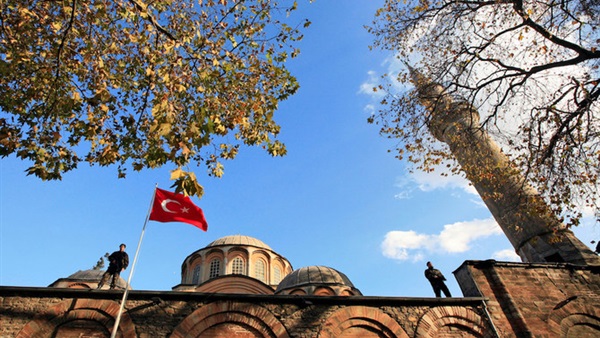Turkey’s cultural wars at full gallop with reconversion of historic church

Just weeks after the first mass prayers were held in
Hagia Sophia, Istanbul’s Church of St Savior in Chora (Kariye) Museum, another
touristic hotspot, is to be opened for Muslim prayers, following a presidential
decree that was published in the Official Gazette on Aug. 21.
Built as a monastery in the 6th century and turned
into a church in Byzantine times in the 11th century, it became a mosque in the
16th century and was then converted into a museum in 1945.
However, this status was annulled last year when
ownership of the building was transferred from the Education Ministry to the
Directorate of Religious Affairs.
The country’s top administrative court, the Council
of State, ruled that a mosque can only be used for its essential function and
claimed that the earlier decision making the building a museum was unlawful.
So far, no date has been set for the first prayers,
but the conversion has stirred widespread debate among Turkish nationals and
international experts on heritage protection, drawing attention to the status of
invaluable mosaics and frescoes that risk being covered up in the ancient
building.
The Edirnekapi neighborhood of Istanbul, where the
building is located, has 16 other mosques around Kariye Museum, sparking
criticisms about the necessity of a move that further polarizes society.
Samim Akgonul, head of the Department of Turkish
Studies at Strasbourg University, thinks that the transformation of former
churches into mosques does not answer a need of Muslim prayer spaces in Turkey.
“These are symbolic and political actions and have
nothing to do with religion. That is why the opening of Hagia Sophia as a
mosque is somehow understandable,” he told Arab News.
Both Hagia Sophia and Chora Church are inscribed on
UNESCO’s World Heritage list as architectural masterpieces. Despite the
restoration works in the building, Kariye Museum attracted about 100,000
tourists last year.
According to Akgonul, Hagia Sophia has always served
as a demonstration of power.
“It demonstrated Byzantine Emperor Justinian’s power
after the Nika revolt, Ottoman Sultan Mehmet II’s power after the conquest of
Constantinople, the founder of Turkish Republic Mustafa Kemal Ataturk’s power
after the foundation of the Republic and now Turkish President Recep Tayyip
Erdogan’s power after the transformation of the regime,” he said.
The status of Hagia Sophia has long been a matter of
debate in the country to reach out to the conservative segments especially
during election times.
However, Akgonul says that Kariye Museum is
different, as it is a largely unknown church compared to Hagia Sophia.
“Its retransformation into a mosque was probably
decided in December 2019 when the decision to change its museum status was
taken but they waited until today so as not to provoke a reaction that could
prevent Hagia Sophia’s transformation. If that is the case, we can say that
it’s a deliberate action and not a coincidence,” he said.
He added: “It is a part of a strategic action to
give pledges to the Islamic and nationalist electorate, saying: ‘We reconquer
the city and the country after a pause.’ And, the sad thing is it works.
Millions of people who never heard the name of Chora, and who will probably
never go there, consider this as a reconquest. After Chora, there are very few
places where one can see the Byzantine heritage in Turkey.”
UNESCO did not immediately react to the move.
Dr. Mine Yildirim, head of Norwegian Helsinki
Committee’s Freedom of Belief Initiative in Turkey, thinks that a serious
commitment to upholding freedom of religion or belief for all would require the
authorities to take measures to reinstate places of worship such as synagogues,
churches or dervish houses, that have lost their original function.
“We know that this is not happening, and there are
many places under the guardianship of the General Directorate of Foundations
that remain as museums, or are being used as libraries or other public
buildings,” she told Arab News.
Yildirim also noted that although some churches and
synagogues have been restored recently, their use by affiliated communities are
subject to the permission of public authorities, and these buildings are not
reinstated to their original function.





